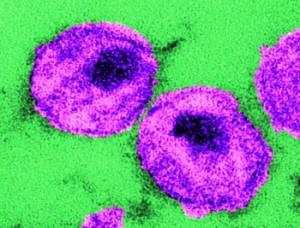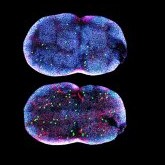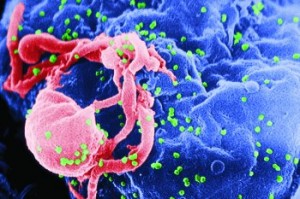
CYNTHIA GOLDSMITH/CDCChameleon: The HIV, in pink, that infects 3 million people every year CYNTHIA GOLDSMITH/CDC
Brazilian immunologist, Michel Nussenzweig, from the Rockefeller University in New York, seems to have found the reply to a question that everybody has been asking researchers – and researchers have been asking themselves – over the last few years: three decades after the discovery of Aids, why has no one yet found a vaccine capable of efficiently stopping the virus that causes it, HIV? The explanation for the lack of success is that the dozens of candidate formulas for the vaccine that have been tested so far were produced on the basis of a strategy that is valid against some viruses, like the one that causes hepatitis B, but not against HIV, which every year still infects 3 million people worldwide.
Just as hunters eliminated werewolves in horror movies, by shooting them in the heart with a silver bullet, it was hoped to annihilate HIV. In the case of HIV, the bullet would be a protein (antibody), capable of adhering to a vital point in the virus and preventing it from penetrating the defense cells of the organism and multiplying. Four of these super-antibodies have already been identified, but not a single one has been capable of detaining the virus; and perhaps not even those produced jointly can do so, since HIV behaves like a chameleon-virus, changing slightly as it reproduces, making the antibodies produced to fight it useless.
Given the disappointing results of this strategy, Nussenzweig and his team decided to try something different. They started investigating how the organism of a special group of people, who produce a wide variety of antibodies against HIV and corresponding to some 10% of those with the virus, fight infection naturally. By analyzing the blood of six of these special carriers, the group from Rockefeller discovered that their organism adopts a different strategy for fighting the virus: instead of producing just one or two types of super-antibodies against HIV, it makes high concentrations of dozens of different antibodies that adhere to different points in the virus, reported the researchers in an article published in the 2 April edition of Nature.
“These patients produce high levels of different antibodies that individually have little neutralizing power, but together are very powerful”, explains Nussenzweig. In this way the elite controllers maintain the virus at extremely low concentrations in the blood – fewer than 50 copies per milliliter – to the point that the appearance of the Aids symptoms are avoided. Those who develop the disease generally have millions of copies of HIV per milliliter of blood.

Gabriel Victora and Tanja Schwickert/Rockefeller UniversityThe map: precursors of dendritic cells (green) in a lymph nodeGabriel Victora and Tanja Schwickert/Rockefeller University
Although immunologists have known about elite controllers for some years now, little was known about how their antibodies faced up to infection. It was impossible to isolate from the blood those defense cells that produce the antibodies: the B lymphocytes that are capable of conserving the mixture of proteins that neutralize the invading microorganisms for months or years.
This situation has only changed recently with the work of German immunologist, Johannes Scheid. A visiting researcher at Nussenzweig’s laboratory and first author of the Nature article, Scheid conceived of a way of separating lymphocytes from the blood of those with the virus. With the help of researchers from Germany and other institutions in the United States (among them, David Ho, one of the forerunners to use the medical cocktail against the virus), he collected hundreds of B lymphocytes from the blood of six people who produced high levels of antibodies against HIV. In all 502 different antibodies were identified, of which 433 bonded with different points of a protein in the virus capsule (gp140) used to adhere to cells in the defense system.
Using genetic techniques, Scheid and Nussenzweig reproduced the antibodies and tested them in the laboratory against the virus. They noticed that separately, none of these 433 proteins had the fire-power of one of the 4 known super-antibodies. But together, in a type of cocktail containing between 20 and 50 varieties, they were more effective than the super-antibodies. “The molecular basis of this activity has not yet been determined, but it may result from a combination of the additive effects of the different antibodies”, wrote the study’s authors.
The researchers do not exclude the possibility that in the future a super-antibody will be found that is able to detain the virus, but they believe that a multiple attack is more viable. “Based on these results”, comments Nussenzweig, “it would appear to be more promising to try and produce a vaccine that has a more global action that simulates what happens in the organism of those individuals who fight the virus naturally”.
But none of this is likely to become available to people very soon. Despite the advance that this discovery represents, years of research will still be necessary until a vaccine is obtained that has properties similar to those with an immune system that controls the virus well. Before, it will be necessary to settle a series of doubts – it is not known, for example, what proportion of each antibody is necessary to neutralize HIV, nor against which strains of the virus this mixture of antibodies may be efficient. Nussenzweig, however, is not discouraged and is betting on a new way of producing immunizers that has been investigated over the last few years: intelligent vaccine design, which uses genetic information to stimulate the production of more effective defenses against viruses, bacteria and other parasites, as well as tumor cells. “Intelligent vaccine design is the 21st century way of thinking about vaccines”, says the immunologist who was born in Brazil, but who has been living in the United States for 40 years.
The success of this new strategy will depend on the ability to control the activity of another type of cell in the immune system, dendritic cells that culminate in the production of antibodies, the evolution cycle of which has just been clarified by Nussenzweig’s team in an article that made the cover of the 17 April edition of Science journal, illustrated by an image obtained by Brazilian immunologist, Gabriel Victora. Called dendrites, because they have projections that are like the branches of a tree (dendron, in Greek), these cells function like sentries in the body.

Cynthia goldsmith/cdcThe birth: copies of the Aids virus (green) recently created in lymphocyte (pink)Cynthia goldsmith/cdc
As soon as they come across viruses, bacteria or even tumor cells (which have lost the characteristics that allow them to be identified as being part of the organism itself), dendritic cells emit a projection that is similar to the tentacles of an octopus and surround, swallow and destroy them. After this destruction mechanism, which is known as phagocytosis, the dendritic cells expose pieces of the invading cell on their own surface and present them to another group of defense cells, the T-lymphocytes, which in turn activate the B-lymphocytes that produce the antibodies.
Mature dendritic cells, which are ready to induce production of antibodies, are found in organs that form part of the immune system, such as the spleen and lymph nodes. They are also present on the skin and membranes that coat organs that are in direct or indirect contact with air, like the nose, lungs and intestines. But for almost 40 years attempts had been made to discover from which cells in the defense system they originated.
In Nussenzweig’s laboratory, researcher Kang Liu had the idea of using proteins found exclusively in mature dendritic cells for identifying their precursors. From the bone marrow of mice she isolated the candidates to be mother of the dendritic cells that were marked with a green fluorescent protein and injected them into genetically identical rodents. With the help of an advanced technique that allows cells of the immune system to be seen in activity in the bodies of live animals (intravital multiphoton microscopy) Kang Liu, Victora and Tanja Schwickert monitored the course of these cells in the bodies of mice and documented the stages of development.
The team from Rockefeller University confirmed that dendritic cells in fact appear inside bones, like other cells in the defense system and while still immature reach the blood stream and spread through the body. Some of them lodge in the spleen and the lymph nodes, where they mature, until a week later they are ready to identify invaders.
Unlike what many immunologists believed, dendritic cells evolve from different parents than those that generate the macrophages, another group of defense cells that are specialists in phagocytosis, but less capable of unleashing immune responses. These are the direct descendents of monocytes, while the former are generated by cells that Nussenzweig’s team called the precursors of dendritic cells (pre-DCs).
“Knowing the precise origin of these cells and all the steps in their development is fundamental for knowing how they can be manipulated to obtain vaccines”, explains Victora. “Identification of the organs in which they develop and are located should help our understanding of the functions they carry out”, adds Nussenzweig. The researchers imagine that the immune response generated depends on the stage of development in which the dendritic cells are stimulated by the invading pathogens.
It is also believed that it is possible to generate a more efficient immunological response by directly supplying dendritic cells with molecules that they recognize as being invading microorganisms. The traditional way of producing vaccines is based on injecting large pieces or inactive forms of virus or bacteria, of which just part reaches the dendritic cells, thus activating the production of a restricted variety of antibodies. The idea of Nussenzweig’s group is to develop techniques that allow much smaller amounts of viral proteins to be directed to the type of dendritic cell necessary to unleash a suitable immune response against HIV, a strategy that should work for other illnesses. Based on this principle, Michel Nussenzweig is working in partnership with his parents, Ruth and Victor, world-renowned immunologists who work at the University of New York, developing a candidate for a malaria vaccine produced by stimulating dendritic cells.
Both the production of vaccines from stimulating dendritic cells, as well as the creation of a new breed of immunizer against HIV, however, are promises that are likely to take years to materialize. After all, as Michel Nussenzweig remembers, his team only recently managed to develop the tools necessary for isolating B lymphocytes and monitoring the development of dendritic cells in live animals. “Four or five years ago”, says the researcher, “this work was impossible”.
Scientific articles
SCHEID, J. F. et al. Broad diversity of neutralizing antibodies isolated from memory B cells in HIV-infected individuals. Nature. v. 458, p. 636-640. 2 abr. 2009.
LIU, K.; VICTORA, G. et al. In vivo analysis of dendritic cell development and homeostasis. Science. v. 324, p. 392-397. 17 abr. 2009.